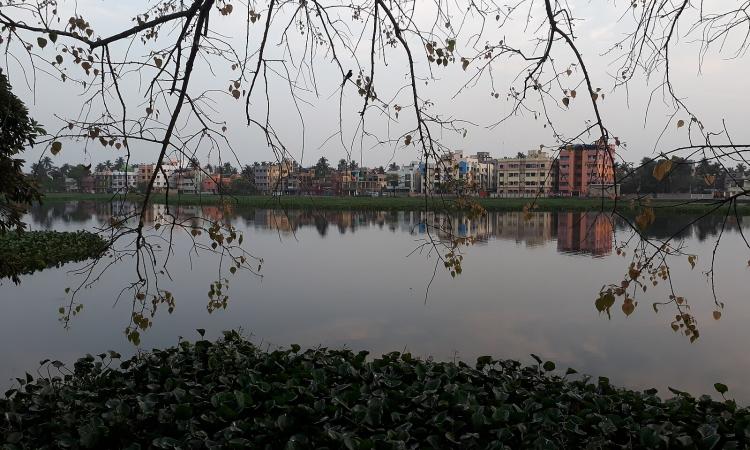
Biomonitoring, to assess the pollution levels in water bodies
Using organisms living in the water as indicators of the status of water bodies (biomonitoring) provides a number of advantages over chemical analysis. It is difficult and expensive to measure all the organic and inorganic chemical pollutants entering a river, and to study the combined impacts of these factors on water quality. But living communities reflect the integrated effects of all the compounds that find their way deliberately and accidentally into watercourses, and hence they act as sensitive indicators of the state of the environment.
Biomonitoring can show evidence of damage over longer periods of time even when all chemical traces of a major pollution have disappeared from a river. This is because organisms living in the water integrate the impacts of pollutants over space and time.
Macrozoobenthos/Benthic macroinvertebrates, small animals living at the bottom of a water body
Some organisms living at the bottom of the water column are visible to the naked eye, and are called as benthic macroinvertebrates or macrozoobenthos, and form an important part of the biological aquatic community.
These individual organisms react in different ways to the variations in their physical and chemical environment that includes variations in natural parameters such as radiation balance, temperature, flow, oxygen levels and the structure of the river bed and pollution from point and non-point sources.
Assessing water quality
Water quality of lotic (flowing waters such as streams) and lentic (still waters such as lakes) waterbodies can be measured through physicochemical parameters such as temperature, Dissolved oxygen (DO), Chemical oxygen demand (COD), Biochemical oxygen demand (BOD), pH, chlorides, alkalinity.
However, this only provides a quick snap-shot of the condition of a waterbody while biomonitoring using benthic macroinvertebrates provides a detailed, comprehensive assessment of the health of a waterbody over a long period of time informs this paper titled 'Biological assessment of major water bodies of metropolitan region Kolkata' published in Rec. zool. Surv. India.
Benthic macroinvertebrates include small aquatic animals and larval stages of insects such as dragonfly and stonefly larvae, snails, worms, beetles, etc. The ubiquitous and sedentary nature of benthic macroinvertebrates, their cumulative response to stress, the length of their life cycles, and their long-term exposure to toxic substances makes them ideal subjects of study to evaluate the changes occurring in the aquatic environments where they reside. Benthic macroinvertebrates usually live in contact with sediments in the water, which exposes them to various pollutants, thus affecting their community structures in terms of species richness and functional diversity based on the level of exposure to pollutants.
The study
In India, various studies have been conducted on rivers using benthic macroinvertebrates. However, such studies are scarce for in case of water bodies of Kolkata. The present study was undertaken to explore the water quality status of four water bodies in Kolkata.
Rabindra Sarovar, Subhash Sarovar, Santragachi Jheel and East Kolkata Wetlands were selected for water quality monitoring. Rabindra Sarovar Lake is a 72-acre artificial lake located near Dhakuria with a length of 1770 m and a width of 206 m. It is a rainfed water body and is mainly used for recreational activities. Subhas Sarovar Lake is also a manmade artificial lake located at Beleghata covering an area of approximately 39 acres and is used by people for bathing, washing clothes, dumping food leftovers, etc.
Santragachi Jheel, locally known as ‘Makal Jheel’ is an important urban wetland of Howrah, West Bengal, India. It is spread over an area of almost 31.57 acres and attracts a number of migratory birds in the winter season. East Kolkata Wetlands or sewage-fed fish ponds located in the Eastern region of Kolkata cover an area of nearly 30888.173 acres and consists of 37 mouzas of South and North 24 Parganas district and Kolkata district. It is an important Ramsar site and is known to be one of the largest waste waters fed aquaculture systems in the world. This wetland is also called the “Kidney of East Kolkata” as it has a crucial role in purifying sewage water.
Findings
- The study found that all the four sites namely Ravinder Sarovar, Subhash Sarovar, Santragachi Jheel and East Kolkata Wetlands were moderately polluted due to many anthropogenic activities and non-point sources of pollution.
- Dragonflies, damselflies, different varieties of bugs or insects as well as different kinds of snails were found in abundance in the area. However, their presence was directly related to the anthropogenic interventions made at each site with their number considerably reduced in places of intervention due to destruction of habitats.
- Presence of pollution tolerant species like midges and earthworms revealed the high presence of organic pollution in Santragachi Jheel and East Kolkata Wetlands respectively. Assessment of biological water quality from all the sampling stations revealed that the water was unfit for potable use and required treatment.
- The study identified the urgent need for environmentally sound restoration and management of the water bodies, the urgent need for controlling the amount of sewage from entering into the water bodies and environmentally sound management of sewage effluents presently mixing with the water bodies to prevent deterioration of the water bodies in the future.
The paper is available online here in this journal by the Zoological Survey of India.
/articles/monitoring-water-quality-lakes-and-ponds-kolkata